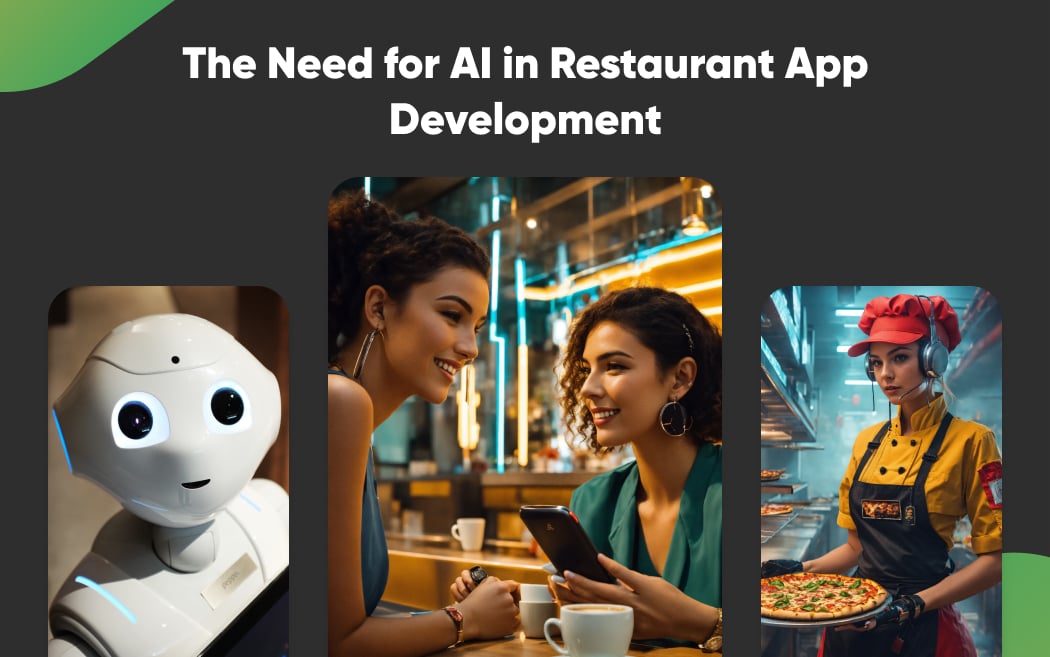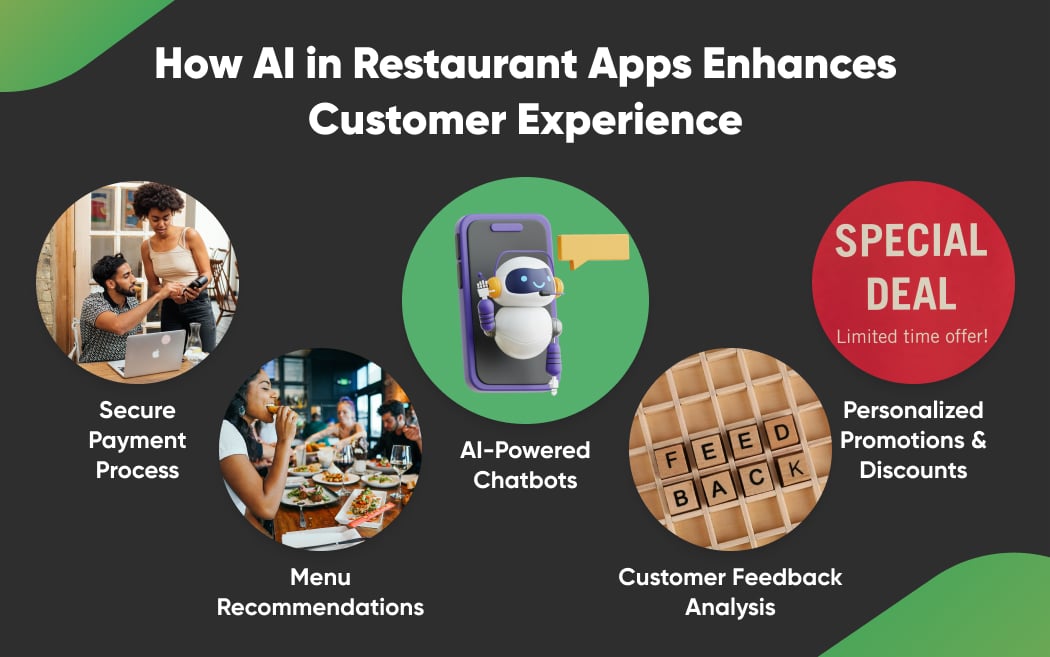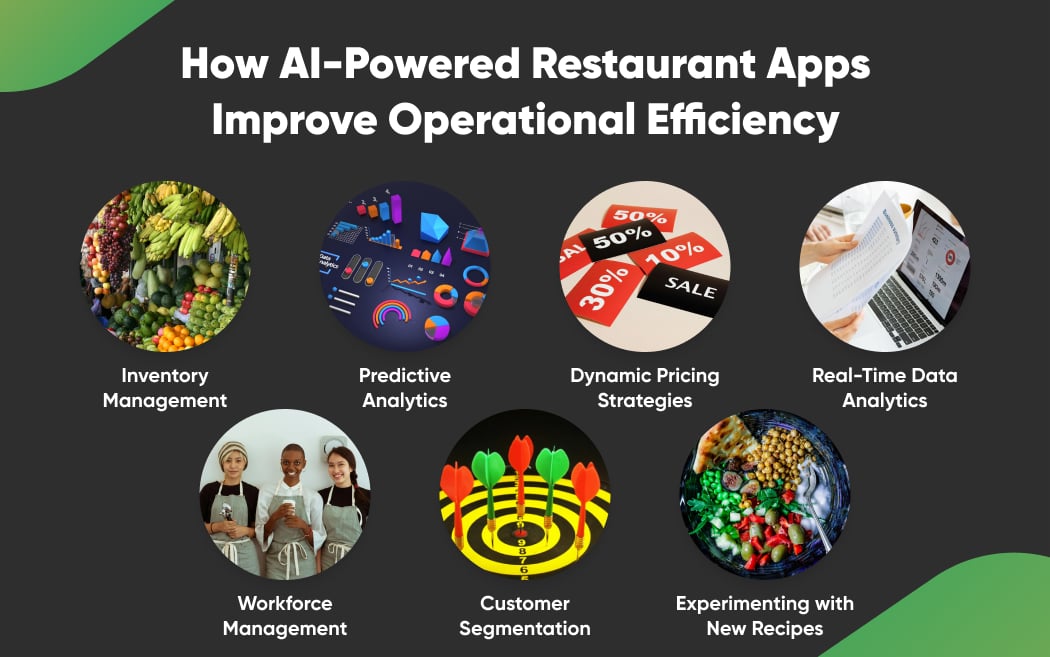The widespread adoption of artificial intelligence (AI) in the restaurant industry has been the talk of the town. Many well-renowned food chain giants, like McDonald’s, Domino’s, Starbucks, and Subway have already been leveraging AI across various aspects of their businesses, including customer service and operation management. In this blog post, we’ll discuss how to use AI in restaurant app development and figure out why restaurant owners shifted their focus toward this technology to boost their customer experience and elevate the success and profitability of their culinary business.
Key Takeaways
- It is anticipated that by 2027, AI in the restaurant industry will have increased to 6.5 billion US dollars in comparison to 651.1 million US dollars in 2019.
- AI in restaurants involves using artificial intelligence technologies to improve various aspects of the dining experience, from personalized recommendations to operational efficiency.
- There are myriad benefits of implementing AI in restaurant apps, such as personalized customer experiences, efficient inventory management, reduced operational cost, optimized staff scheduling, and data-driven decision-making.
- AI enhances the customer experience by offering personalized recommendations, improving service speed through automation, and providing seamless interaction with AI-powered chatbots.
- Restaurant owners can optimize inventory management, predict demand, automate routine tasks, and improve staff scheduling to match peak business hours.
AI in the Restaurant Industry: Why Businesses Need AI-Powered Restaurant Apps

You might be thinking that developing a restaurant mobile or web app would suffice enough to fulfill your business needs and satisfy your customers. That’s true!
The growing demand for restaurant mobile apps couldn’t be denied, especially in this digital era where customers prefer a digital dining experience. With a few clicks on their smartphones, they can order their food online, make table reservations, scan & explore menu cards, pay online, and more.
The real shortfall here is the inability of restaurants to analyze their customers’ sentiments, offer personalized food recommendations, or let customers connect with virtual assistants for quick food ordering and instant customers. That’s where artificial intelligence comes into the picture. It enables restaurants to blend all these AI features and shape them into an engaging and user-friendly restaurant app.
Similarly, restaurants can overcome the hassle of manually managing their daily business operations by automating inventory and staff management. Moreover, they can also conduct in-depth business performance and customer analysis, forecast future inventory needs, retarget customers, and more with the help of AI-powered restaurant apps. And that’s the reason why developing AI is widely adopted in restaurant app development.
How AI in Restaurant Apps Enhances Customer Experience

Now that we have a general understanding of how AI in the restaurant business enhances the dining experience, let’s explore in more detail how app developers integrate AI into restaurant app development to further improve customer satisfaction and keep pace with the current digital dining trends.
AI-Powered Chatbots
The unavailability of customer agents and delayed order processing can frustrate customers, leading them to abandon your restaurants. However, the restaurant mobile apps integrated with AI chatbots emerged as a game changer that automates inquiry processing. AI chatbots minimize human intervention by handling everything from answering frequently asked questions, like menu details or operating hours, to taking reservations and orders.
Customers can also place orders via voice commands while driving or doing other chores effortlessly using voice-activated technology. This means customers get instant, accurate responses anytime they need help. Starbucks app has an integrated AI chatbot called the “Barista,” which allows customers to place orders via voice commands or messaging.
Personalized Menu Recommendations
Do you wish to suggest the perfect dish that your customer likes the most but can’t remember each customer’s eating choices and diet preferences? With AI, you can achieve this without the need to manually note down your customers’ likes and dislikes. AI uses a recommendation engine to offer personalized menu recommendations and suggest meals by analyzing customers’ past purchases, and the food that matches their eating habits and tastes. Additionally, AI can also help you suggest complementary food items that are frequently ordered together using collaborative data patterns.
For instance, the Uber Eats app delivers personalized food and restaurant recommendations tailored to each user’s eating preferences using machine learning and a semantic understanding of food types. If a customer most likely eat spicy food, they will get more suggestions of restaurants selling spicy food in the app.
Secure Payment Process
A restaurant mobile app allows customers to pay online for the food they ordered through multiple payment options. However, these apps might lack security and privacy, which could affect your customer’s personal data and payment information. As a restaurant owner, you can overcome this challenge by effectively implementing AI-driven encryption methods to ensure that every transaction is safe and secure.
Advanced encryption methods protect your customers’ payment information, which reduces the risk of online fraud and threats. What’s even better is that helps to identify potential threats by detecting anomalies and suspicious behavior. With AI’s secure payment processing, customers can securely pay online and enjoy their meals without worrying about the safety of their payment information.
Sentiment Analysis for Customer Feedback
Many restaurant apps enable customers to submit their feedback but skimming through thousands of reviews becomes a daunting task. That’s where sentiment analysis comes in. With this AI technology, your restaurant staff doesn’t need to manually handle the feedback mechanism. AI lets you scan and interpret customer reviews and feedback, and their reactions to determine the overall sentiment—whether it’s positive, negative, or neutral.
It helps in understanding whether eaters like or dislike the food they ordered from your restaurant and what improvements they look forward to in the food by providing their suggestions and feedback. This helps you to make informed decisions to enhance your food offerings and ensure customers receive a consistently positive experience.
Personalized Promotions and Discounts
If you want to boost your customer loyalty, make them feel special, and drive sales, there’s no better way than to offer targeted discounts, deals, or promotions. But how can you streamline this process? Using AI within your restaurant app development. AI can analyze your customer’s purchase history and preferences to offer personalized promotions and discounts.
Whether it’s a special discount on your customer’s favorite menu item or a loyalty reward for their frequent visits to your restaurant, these tailored offers make your customers feel valued and encourage them to keep coming back. Overall, this AI-powered technology integrated into a restaurant mobile app can create a win-win situation for both the customer and the business.
Leveraging AI in Restaurant Business Apps to Improve Operational Efficiency

Wondering how to use AI in restaurant business apps? AI can transform how you run your restaurant and manage operations by automating routine tasks and optimizing workflows. This includes managing reservations, streamlining kitchen operations, and handling customer orders. With AI, you can reduce errors, speed up service, and make better use of your staff’s time. Let’s explore these in detail:
Inventory Management Optimization
AI takes the guesswork out of inventory management by continuously monitoring stock levels and predicting future needs based on historical data. This means you’ll know exactly how many ingredients you currently have and when you should reorder ingredients, which helps prevent shortages and overstocking. AI can also identify slow-moving inventory items and suggest adjustments to minimize waste.
For example, Sweetgreen a fast-casual food business in the USA fits as a great example here, as they seamlessly leveraged machine learning algorithms to predict demand and adjust inventory levels automatically in order to maximize their inventory management.
Predictive Analytics for Demand Forecasting
Using AI predictive analytics. You can build a smart restaurant app by leveraging predictive analytics, which uses historical and current data to predict what’s going to happen in the future, what are the upcoming trends, and what new food or menu items will customers be interested in.
Most importantly, with predictive analytics, you can overcome the problem of food wastage and avoid overproduction. You can do so by analyzing customer order history and predicting the items that are more likely to be popular or ordered the most. Moreover, you can also plan promotions, and tailor your marketing efforts and menu offerings to match upcoming trends and customer preferences. This technology leads to data-driven decision-making and ensures your restaurant remains competitive and responsive to changing market dynamics and customer preferences.
Dynamic Pricing Strategies
AI enables you to implement dynamic pricing strategies by analyzing factors such as demand, competition, and weather conditions. This means you can adjust menu prices in real-time to attract more customers during slow periods or maximize profits during peak times. Dynamic pricing helps you stay competitive and responsive to market conditions. Using AI, you can increase revenue, improve customer satisfaction, and gain a competitive edge.
For instance, a coffee shop might use AI in its restaurant app to lower prices on hot beverages during unusually cold days to drive higher customer traffic. Alternatively, during peak morning hours, prices might be slightly increased to maximize profits without significantly affecting demand. This intelligent pricing strategy ensures your restaurant remains profitable and appealing to customers at all times.
Real-Time Data Analytics and Reporting
AI provides real-time data analytics and reporting, giving you a clear and immediate view of your restaurant’s performance. This includes tracking sales, monitoring customer behavior, and analyzing operational efficiency. With these insights, you can make informed decisions quickly, from adjusting menu items to optimizing staff schedules. Real-time analytics help you identify trends, spot issues early, and implement changes that drive improvement.
Let’s say you notice a sudden drop in sales of a particular dish; here AI in the restaurant business works wonders by analyzing which menu item is most disliked and how you can adjust the recipe or marketing accordingly to entice customers. This proactive approach ensures your restaurant operates at its best by enhancing customer satisfaction and boosting overall profitability.
Workforce Management and Task Scheduling
If you’re tired of manually managing your operations and workforce staff, AI is what you implement within your restaurant app. AI helps restaurants simplify their workforce management and scheduling by analyzing factors like employee availability, peak business hours, and labor laws. You can also create optimal schedules and allocate the right number of staff both during busy and slow working hours.
You can achieve this with AI as it predicts future staffing needs based on historical data and upcoming reservations. It can also automate the handling of last-minute schedule changes and shift swaps, making the process seamless for both managers and employees.
Likewise, restaurant owners can employ performance tracking and shift management to reduce labor costs and improve service quality. As a result, this comprehensive approach boosts operational efficiency and fosters a more satisfied and engaged workforce.
Customer Segmentation and Targeting
AI enhances customer segmentation and targeting by analyzing customer data to identify distinct groups based on behavior, preferences, and demographics. This allows you to create targeted marketing campaigns that resonate with each segment, which increases engagement and sales. AI can help you identify high-value customers, introduce new food items to the right audience, tailor promotions to specific groups, and deliver personalized experiences.
You can allocate your marketing resources more effectively and achieve higher returns by better understanding your customer base. Furthermore, with AI in the restaurant business, you can track changes in customer behavior over time and adjust your strategies dynamically. This continuous feedback loop ensures that your marketing efforts remain relevant and effective. It ultimately leads to improved customer loyalty and higher lifetime value.
Experimenting with New Recipes and Flavors
If you want to succeed in the restaurant industry, it’s essential to experiment with new recipes, add new varieties to the menu, or modify the existing ones to cater to a wide range of diners. Here, AI can assist you in analyzing popular ingredients, customer preferences, and food trends to suggest new recipes and flavor combinations. This data-driven approach allows you to experiment confidently, knowing there’s a demand for the new items.
AI can also help you tweak existing recipes after analyzing customer suggestions and feedback. You can keep your menu fresh and exciting to attract new customers and delight existing ones with novel dishes. Additionally, integrating QR codes with your AI-powered restaurant app can enhance this process. Customers can scan QR codes to provide instant feedback on new dishes, allowing you to gather real-time data on their preferences. This feedback loop helps you refine recipes quickly and ensures your offerings stay relevant and popular.
The Bottom Line
AI has been extensively used in restaurant app development in recent years due to its extensive capabilities and smart algorithms. It helps you understand each diner’s unique eating habits and preferences and lets you tailor your recommendations accordingly; basically, its recommendation engine works like a charm. To add more, sentiment analysis analyzes whether customers like or dislike your dish and what their reactions are towards it. Most importantly, the ease of voice-activated ordering and chatbot assistance take customer experience to a whole new level.
From a business perspective, they can leverage AI in restaurants to optimize inventory management, forecast demand, automate staff scheduling, implement dynamic pricing strategies, and more. Long story short, AI in the restaurant industry boosts sales, drives operational efficiency, and enhances customer engagement.











